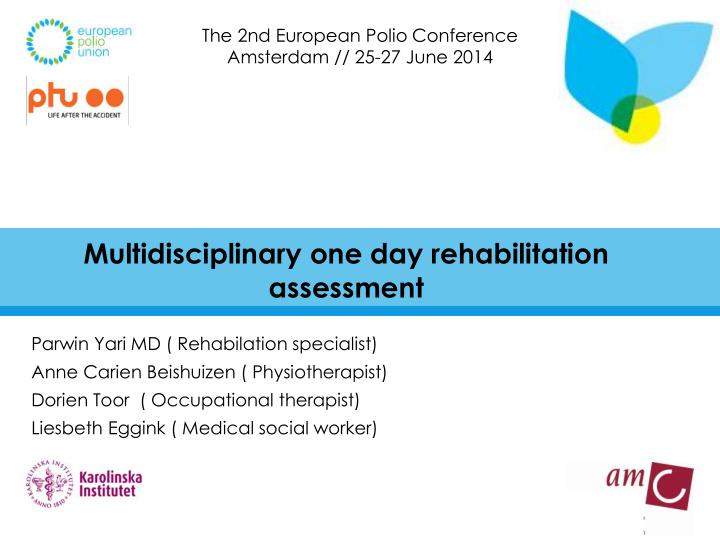



The 2nd European Polio Conference Amsterdam // 25-27 June 2014 Multidisciplinary one day rehabilitation assessment Parwin Yari MD ( Rehabilation specialist) Anne Carien Beishuizen ( Physiotherapist) Dorien Toor ( Occupational therapist) Liesbeth Eggink ( Medical social worker)
Content 1 How is the Multidisciplinary one-day Rehabilitation assessment achieved? P.Yari 2 Who is eligible to participate? P.Yari 3 How is the day organized? A.C Beishuizen, D. Toor, L. Eggink , P.Yari 2
Content 1 How is the Multidisciplinary one-day Rehabilitation assessment achieved? P.Yari 2 Who is eligible to participate? P.Yari 3 How is the day organized? A.C Beishuizen, D. Toor, L. Eggink , P.Yari 3
1- How is the Multidisciplinary one-day assessment achieved? Post polio expertise centre 15,000 people in the Netherlands are registered as having poliomyelitis Immigrants and foreign nationals with polio In AMC 1/3 of all polio patients are foreign Younger, more complex patients 4
1- How is the Multidisciplinary one-day assessment achieved? Initially, only diagnosis was performed In 2007 the first One-day assessment was organized 5
Content 1 How is the Multidisciplinary one-day Rehabilitation assessment achieved? P.Yari 2 Who is eligible to participate? P.Yari 3 How is the day organized? A.C Beishuizen, D. Toor, L. Eggink , P.Yari 6
2- Who is eligible to participate? Referral letter • Rehabilitation specialist Interview and physical examination Additional tests - muscle MRI - x-ray - or gait analysis 7
2- Who is eligible to participate? • Criteria for participation • Goal of the session 8
2- Who is eligible to participate? Criteria for participation: multiproblems questions about managing symptoms 9
2- Who is eligible to participate? Goal of the session give insight into which factors lead to problems 10
Content 1 How is the Multidisciplinary one-day Rehabilitation assessment achieved? P.Yari 2 Who is eligible to participate? P.Yari 3 How is the day organized? P.Yari , A.C Beishuizen, D. Toor, L. Eggink 11
3- How is the day organized? Two patients a month Questionnaire 12
3- How is the day organized? The most attention is paid to the main problem! Topic issues: Reduction of pain, tiredness and overload Improving fitness, exercise and sport Advice on home and work adjustments Advice on the use of walking aids Social and emotional items - how to deal with physical complaints, with acceptance, with fear of being dependent and with concerns about the future 13
3- How is the day organized? Physiotherapist Occupational therapist Medical social worker Rehabilitation physican 14
Expert advice … that moves boundaries snapshots on my timeline 15
Physiotherapist Preparations Case history - patients needs! Examination Report and proposal for improvements
Physiotherapist Preparation: Medical history General information MRI muscles Muscle condition X-ray Joint problems Gait analysis Walking problems Questionnaire Patient’s needs Polio Problem List Patient’s main problems CISS questionnaire Coping strategies Daily activity list Daily activities
Physiotherapist Case History: Exploration of the patient’s needs The three main problems of the Polio Problem List
Physiotherapist Examination: 2 minute Walking Test Submaximal Cycle Test Joint Mobility Observing Problem Activities and Transfers Borg Scale/Rating of Perceived Exertion 6 minute Walking Test Observing Effects of Walking Aids
Physiotherapist Report and proposal for improvement: Outcomes of diagnostic tests Recommendations for therapy
Physiotherapist Goals of the intervention: • Understanding the problems, origins and consequences • Finding a proper balance between physical capacities and physical activities
Occupational Therapist Preparations Case history - patients needs! Examination Report and proposal for improvements
Occupational Therapist Preparations: Medical history General information MRI muscles Muscle condition X-ray Joint problems Gait analysis Walking problems Questionnaire Patient’s needs Polio Problem List Patient’s main problems CISS questionnaire Coping strategies Daily activity list Daily activities
Occupational Therapist Case history: semi-structured interview: COPM (Canadian Occupational Perfomance Measure) Activities which lead to overload, pain, Problems with daily living and work tiredness and/or unsafety situations? skills? exploration of the physical and social environment
Occupational Therapist Examination: Daily Activity List Observations
Occupational Therapist Report and proposal for improvement: Findings and conclusions Recommendations for therapy Common goals for further therapy: adjust heavy daily activities advices for aids improving sitting positions
Medical Social Worker Preparations Case history - patients needs! Examination Report and proposal for improvements
Medical Social Worker Preparations: Medical history General information MRI muscles Muscle condition X-ray Joint problems Gait analysis Walking problems Questionnaire Patient’s needs Polio Problem List Patient’s main problems CISS questionnaire Coping strategies Daily activity list Daily activities
Medical Social Worker The Goal : To assess the social functioning of the patient. To advice on the treatment and assistance.
Medical Social Worker Case History: Exploration of the patient’s needs The three main problems of the Polio Problem List Balance in social functioning
Medical Social Worker Examination Focus during the consult: the aid request the findings, by using the CISS questionnaire (Coping Inventory for Stress Situations) and HADS questionnaire (Hospital Anxiety and Depressions Scale) - Task-oriented coping - Emotion-oriented coping - Avoidance-oriented coping
Medical Social Worker Advise: Patient can cope the problem Contact social medical worker/psychologist
Medical Social Worker Conclusion Most common request for aid : Finding a balance in life. The struggle in dealing with the limitations, that the patient has experienced for years.
Rehabilitation Physican Preparation: Medical history General information MRI muscles Muscle condition X-ray Joint problems Gait analysis Walking problems Patient ’ s needs Questionnaire Patient ’ s main problems Polio Problem List CISS questionnaire Coping strategies Daily activity list Daily activities 34
3- How is the day organized? Team meeting without patient for 15 minutes Team meeting with patient for 30 minutes - Further treatment necessary? 35
Orthosis 36
3- How is the day organized? A full report is sent within 2 weeks Telephone evaluation 37
Disclosure sheet Disclosure of speaker ’ s interest (Potential) conflict of interest None Potentially relevant company relationships in connection with event Sponsorship of research funding • Fee or other (financial payment) • Shareholder • Other relationships, i.e. • 38
Thank you for your attention! Questions? 39
Recommend
More recommend